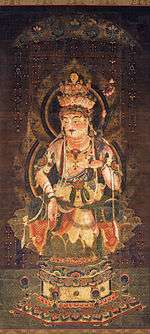List of Cultural Properties of Japan - paintings (Aomori)
This list is of paintings located within the Prefecture of Aomori, Japan, that have been designated Cultural Properties.[1]
National Cultural Properties
As of 1 September 2013, zero properties have been designated as being of national significance.[2][3][4]
Prefectural Cultural Properties
As of 14 August 2013, six properties have been designated at a prefectural level.[4][5]
| Property | Date | Municipality | Ownership | Comments | Image | Dimensions | Coordinates | Ref. |
|---|---|---|---|---|---|---|---|---|
| Byōbu with map of the world 世界地図屏風 sekai chizu byōbu | early Edo period | Aomori | private | 6 panels | 40°49′34″N 140°45′00″E / 40.826150°N 140.749948°E | |||
| Shinran and associated figures 親鸞上人連座御影 Shinran shōnin renza miei | Muromachi period | Ajigasawa | Raishō-ji (来生寺) | 1 scroll, colours on silk; at the top is Hōnen and, below, Shinran (founder of the Jōdo Shinshū school) and his disciples[6] | .jpg) | 143.0 centimetres (56.3 in) by 48.0 centimetres (18.9 in) | 40°46′57″N 140°12′05″E / 40.782442°N 140.201286°E | |
| Image of Amida Nyorai 阿弥陀如来像 Amida Nyorai zō | Muromachi period | Ajigasawa | Raishō-ji (来生寺) | 1 scroll, colours on silk; the 48 rays of light symbolise Amida's 48 vows[6] | .jpg) | 134.0 centimetres (52.8 in) by 38.0 centimetres (15.0 in) | 40°46′57″N 140°12′05″E / 40.782442°N 140.201286°E | |
| Taima Mandala, colours on silk 絹本著色当麻曼荼羅図 kenpon chakushoku Taima Mandara-zu | Kamakura period | Hirosaki | Teishō-ji (貞昌寺) | displayed every year at the spring and autumn equinox; affected by flaking[7] | .jpg) | 40°35′39″N 140°27′42″E / 40.594265°N 140.461621°E | ||
| Byōbu with scenes of cherry- and maple-viewing, colours on paper (by the brush of Arai Seihō) 新井晴峰筆紙本著色観桜観楓図屏風 Arai Seihō-hitsu shihon chakushoku kanō kanpō-zu byōbu | late Edo period | Hirosaki | Hirosaki City (at Hirosaki City Museum (弘前市立博物館)) | pair of screens, each with 6 panels[8] | _-_right.jpg) _-_left.jpg) | 40°36′19″N 140°27′45″E / 40.605262°N 140.462555°E | ||
| Image of Shōbō, colours on silk 絹本著色聖宝僧正像 kenpon chakushoku Shōbō sōjō zō | C14 (first half) | Fukaura | Engaku-ji (円覚寺) | 1 scroll; brought to Engaku-ji in the Meiji period; during repairs in 2003 two paper slips dating to repairs in 1772 were discovered, documenting that prior to that year the painting was housed in the Jōrokudō at Daigo-ji, founded by Shōbō; there are few mediaeval images of important non-Zen Buddhist figures in Tōhoku | .jpg) | 40°38′32″N 139°55′22″E / 40.642256°N 139.922755°E | ||
See also
References
- ↑ "Preservation and Utilization of Cultural Properties" (PDF). Agency for Cultural Affairs. Archived from the original (PDF) on 26 September 2013. Retrieved 27 September 2013.
- ↑ 国宝・重要文化財 [Count of Monuments of Japan by Prefecture] (in Japanese). Agency for Cultural Affairs. 1 September. Archived from the original on 30 June 2011. Retrieved 27 September 2013. Check date values in:
|date=(help) - ↑ "Database of National Cultural Properties: 国宝・重要文化財(美術品)(絵画 青森県)" (in Japanese). Agency for Cultural Affairs. Retrieved 27 September 2013.
- 1 2 国・県指定文化財一覧 [Summary of National and Prefectural Cultural Properties] (in Japanese). Aomori Prefecture. 14 August 2013. Retrieved 27 September 2013.
- ↑ 都道府県別指定等文化財件数(都道府県分) [Count of Prefectural Cultural Properties by Prefecture] (in Japanese). Agency for Cultural Affairs. 1 May 2013. Archived from the original on 21 September 2013. Retrieved 27 September 2013.
- 1 2 県重宝 [Prefectural Treasures] (in Japanese). Ajigasawa Town. Retrieved 27 September 2013.
- ↑ 絹本著色当麻曼荼羅図 [Taima Mandala, colours on silk] (in Japanese). Hirosaki City. Retrieved 27 September 2013.
- ↑ 新井晴峰筆 紙本著色観桜観楓図屏風 [Byōbu with scenes of cherry- and maple-viewing, colours on paper (by the brush of Arai Seihō)] (in Japanese). Hirosaki City. Retrieved 27 September 2013.
External links
- (in Japanese) Cultural Properties in Aomori Prefecture
This article is issued from
Wikipedia.
The text is licensed under Creative Commons - Attribution - Sharealike.
Additional terms may apply for the media files.
